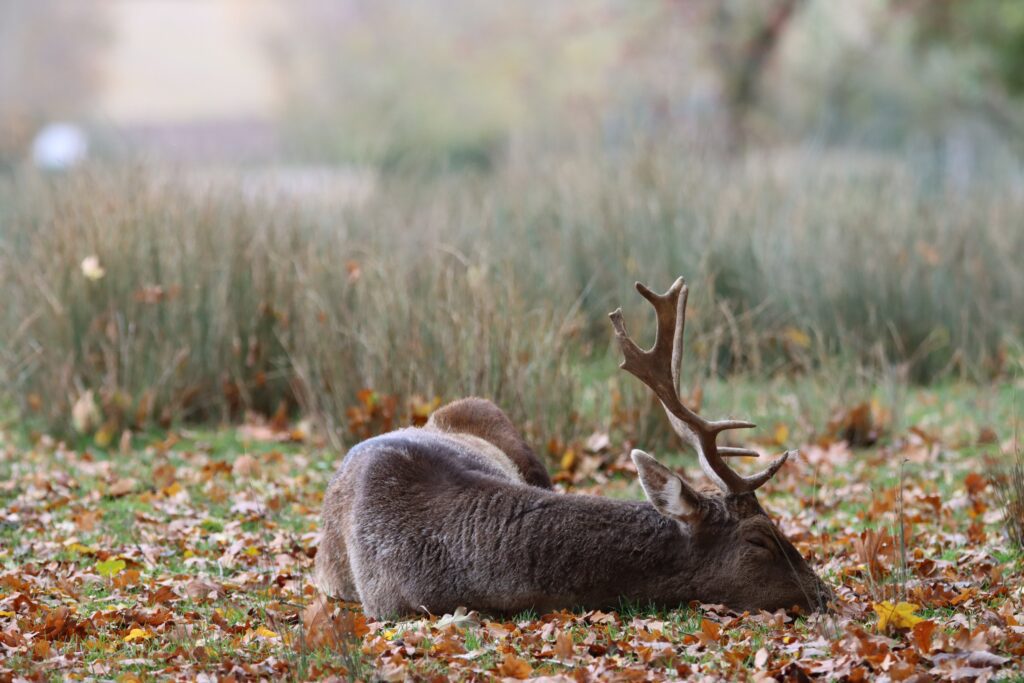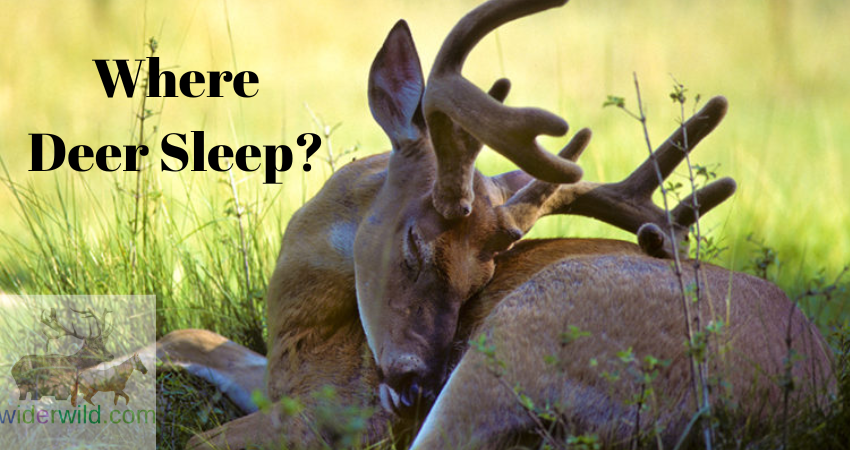Deer sleep in grassy areas and under cover of dense vegetation, such as thickets or forests. Deer are fascinating creatures that are widely distributed across the globe.
They belong to the family Cervidae, which includes various species like the white-tailed deer, red deer, and mule deer. Known for their graceful appearance and gentle demeanor, deer have distinct habits and behaviors, one of which is their sleeping patterns.
Have you ever wondered where deer sleep?
I will explore the preferred sleeping spots of deer. Understanding their sleeping habits can provide insights into their survival and behavior, as well as help us appreciate these beautiful creatures even more.
So, without further ado, let’s delve into the world of deer and discover where they rest their weary heads.
Simplifying Deer’s Home: Where Deer Live
Deer sleep in various locations within their natural habitat, including dense thickets, tall grasses, and wooded areas. These secluded spots provide them with the necessary protection from predators and the elements.
Understanding the Natural Habitat of Deer
Deer are amazing animals that live in the wild and adapt to different homes all over the world. For those of us who love nature and watching wildlife, it’s important to learn about where deer sleep.
When we know why they pick their nap spots and what kind of places they like, we can admire these elegant creatures even more.
Different Types Of Habitats Suitable For Deer
Deer can adapt to a wide range of habitats, enabling them to survive and thrive in diverse environments.
Here are some of the habitats where you are likely to find different species of deer:
Forests: Deer are commonly found in dense forests, where they can seek refuge among the trees and vegetation. Forests provide deer with a constant supply of food, shade, and protection from predators.
Whether it’s temperate deciduous forests, coniferous forests, or tropical rainforests, these habitats offer various resources that sustain deer populations.
Grasslands and meadows: Open grasslands and meadows are another preferred habitat for deer. These areas provide ample grazing opportunities and allow deer to socialize and mate more openly. The openness of these habitats also offers better visibility for deer to spot potential predators.
Wetlands: Certain species of deer, such as the marsh deer and the water deer, are specialized to live in wetland habitats. These areas typically consist of marshes, swamps, and the edges of lakes and rivers.
Wetlands provide a wide range of aquatic vegetation and water sources that are essential for the survival of these deer species.
Mountains: Mountainous regions attract deer due to their unique vegetation, including alpine meadows and shrubs that provide nutritious forage. These habitats also offer a higher degree of seclusion and protection from predators.
Factors That Influence Deer’s Choice Of Sleeping Locations
Deer are highly selective when it comes to choosing their sleeping locations.
Here are some factors that influence their choice:
Security: The primary consideration for deer when selecting a sleeping spot is security. They prefer locations that provide cover and concealment, such as thickets, dense vegetation, or areas with natural barriers like rocks or fallen trees.
These locations allow them to hide from predators and reduce the chances of being detected.
Comfort: Just like humans, deer seek comfort when they sleep. They choose locations that have soft bedding materials, such as tall grass, leaves, or moss. These materials provide cushioning and insulation, enhancing their sleeping experience.
Temperature regulation: Deer are intelligent animals that understand the importance of regulating their body temperature. During colder months, they look for sleeping spots that offer shelter from harsh winds and cold temperatures.
Conversely, in warmer months, they seek out locations that provide shade and relief from the heat.
Proximity to food and water sources: Deer are herbivores and access to food and water is crucial for their survival. They often select sleeping locations that are near these essential resources, allowing for easy access when they wake up.
When we learn where deer like to live and why they pick their nap spots, we can admire them even more. Deer can be found in forests, open fields, wetlands, and mountains because they’ve adjusted to different places to stay safe.
So, when you see a deer snoozing in the wild, know that they’ve thought about it to find the best spot.
Daily Activity Patterns Of Deer

Photo by Patrice schoefolt
Deer exhibit varied daily activity patterns, including sleeping. They typically choose secluded areas like dense vegetation or forested areas to rest and sleep, helping them stay hidden from predators.
Exploring The Feeding And Resting Patterns Of Deer
A deep understanding of the daily activity patterns of deer can provide valuable insights into various aspects of their lives. From their feeding habits to their sleeping cycles, each aspect plays a crucial role in understanding the behavior of these majestic creatures.
How Deer’s Sleep Is Affected By Their Activity Schedule
The sleep patterns of deer are directly linked to the activities they engage in during the day. Unlike humans, deer are most active during dawn and dusk, a behavior known as crepuscular activity.
During these periods, they exhibit heightened alertness and engage in various activities such as foraging, grooming, and socializing.
Because of their crepuscular activity, deer have a unique sleep-wake schedule. They typically spend the majority of their day resting and conserving energy to be active during their prime hours.
Their sleep is often divided into several short periods, known as “catnaps,” which allows them to remain vigilant and quickly respond to any potential threats or changes in their surroundings.
To adapt to their environment and conceal themselves from predators, deer often select secluded and safe resting spots. These can include thickets, dense forests, or areas with thick underbrush.
Deer stay safe when they sleep in secure spots, which helps them avoid predators and boosts their odds of staying alive.
Interestingly, deer are also known to practice what is commonly referred to as “yarding.” During winter months, when food sources are scarce and temperatures drop, deer gather in groups and seek shelter in dense vegetation.
This behavior not only helps them conserve heat but also promotes socialization and the sharing of body warmth within the herd.
Despite their ability to adapt their sleep patterns to their activity schedule, deer still require sufficient rest to maintain their overall health and well-being. Adequate sleep allows them to stay alert, maintain energy levels, and effectively carry out their essential activities such as foraging and mating.
The daily activity patterns of deer significantly influence their sleep habits. Crepuscular activity, catnapping, and the selection of secure resting spots all contribute to their unique sleep-wake cycle.
Learning about these habits lets us truly understand how deer live and helps us take better care of where they call home.
Preferred Sleeping Spots Of Deer
When finding a suitable place to rest, deer have their preferred sleeping spots. Understanding these areas can provide valuable insights into their behavior and help wildlife enthusiasts and hunters alike.
Examining The Various Commonly Utilized Areas For Deer To Sleep
Deer are adaptive creatures that are capable of finding suitable sleeping spots in various environments. Depending on the available resources and habitat characteristics, deer may opt for different locations. Let’s take a closer look at some of their commonly utilized areas for sleeping:
Factors That Make A Spot Ideal For Deer To Rest
Deer prefers specific attributes when choosing a suitable sleeping spot.
These factors contribute to making a location ideal for them to rest:
Security: The primary concern for deer when selecting a sleeping spot is security. They prefer areas with limited visibility and ample cover where they can remain hidden from potential threats.
Such spots may include dense foliage, thickets, or areas with natural barriers like rivers or steep terrain.
Food Availability: Deer have a grazing nature, and proximity to available food sources is crucial. They often choose sleeping spots near feeding areas, such as agricultural fields, meadows, or dense vegetation where they can easily access their preferred food.
Water Sources: Easy access to water is essential for deer, particularly during hot and dry periods. Therefore, they tend to select sleeping spots near natural water sources like streams, ponds, or lakes. These spots allow deer to quench their thirst without venturing too far away.
Adequate Shelter: Deer need shelter from harsh weather conditions, especially during colder months. Dense forests, coniferous thickets, or areas with abundant shrubbery provide the necessary cover and help protect them from strong winds, heavy rains, or snowfall.
Elevation: Deer often prefer higher elevations for their sleeping spots. These elevated areas provide better visibility and a vantage point for monitoring their surroundings, making it easier to detect potential threats in advance.
Knowing where deer like to sleep and what makes a good resting place is essential for nature lovers and hunters. When you understand these spots and what attracts deer to them, you’ll have a better shot at seeing them in the wild or finding them during hunting season.

Credit: about deer
Shelter Choices For Deer During Sleep
When finding a safe and comfortable place to rest, deer are quite selective. These graceful creatures have their particular preferences when it comes to their sleeping areas.
Investigating the deer’s preference for sheltered sleeping areas will provide useful insights into their behavior and habitat selection.
Investigating The Deer’s Preference For Sheltered Sleeping Areas
Deer are generally cautious animals, and this caution extends to their choice of sleeping spots. They seek areas that provide both shelter and security, ensuring they can rest undisturbed. Deer exhibit a strong preference for sheltered locations that offer protection from predators, extreme weather conditions, and human activity.
When selecting a sleeping area, deer prioritize their safety above all else. They tend to choose areas that have good visibility, allowing them to keep an eye out for potential threats. This visibility ensures that deer can quickly detect any approaching predators and have ample time to escape.
Moreover, deer prefer to sleep in secluded spots, away from heavily populated areas. They often seek out dense vegetation such as thickets, woods, and overgrown areas as shelter during sleep. These areas provide excellent camouflage and concealment, making it harder for predators to locate them.
Additionally, deer also exhibit a preference for sleeping near water sources, such as streams or ponds. Not only do these areas provide a source of hydration, but they also offer an additional layer of protection. Water acts as a natural barrier, deterring predators from approaching, which makes it an ideal choice for deer to spend their tranquil slumber.
Different Types Of Natural And Man-made Shelters Deer Seek Out
Deer are adaptable creatures and will utilize a range of natural and man-made shelters as per their availability. Let’s take a closer look at some of the shelter choices deer seek out:
| Natural Shelters | Man-made Shelters |
|---|---|
|
|
Deer rely on both natural and human-made shelters to stay safe and get the peace they need when they sleep. They have various options to pick from, so they can find a comfy spot no matter where they are.
When we understand what they like, we can appreciate the kind of places they need and how they behave. So, when you’re out exploring nature, look for these shelters that deer find comforting.
Withstanding Different Weather Conditions
Deer are fascinating creatures that have evolved amazing strategies to cope with the challenges posed by various weather conditions during their sleep.
These strategies enable them to stay warm, and protected, and ensure their survival even in the harshest of winters.
Read More: When deer attack
How Deer Adapt To Various Weather Conditions During Sleep
Deer are highly adaptable animals that are equipped to handle a wide range of weather conditions while they sleep. Their remarkable ability to adjust their behavior and physiology plays a crucial role in ensuring their survival.
Here are some ways deer adapt to different weather conditions:
Strategies Deer Employ To Stay Warm And Protected During Winter
When the winter season arrives, deer face the challenge of staying warm and protected against the biting cold and snow. They employ several strategies to combat these harsh conditions and maintain their well-being. Some of the main strategies include:
Growing a thicker winter coat: To insulate themselves from the cold, deer grow a thicker winter coat. This coat acts as a protective barrier, trapping air close to their bodies and providing them with much-needed warmth.
Seeking shelter: Deer are resourceful at finding sheltered areas during winter. They often take refuge in dense forests, where trees provide cover from the wind and snow. Additionally, they may seek out areas with natural features like rock formations or thick vegetation that offer further protection.
Increasing feeding: To generate internal heat, deer increase their feeding during the winter months. By consuming more food, their bodies generate energy, which in turn helps maintain their body temperature. This increased feeding also helps them stock up on fat reserves that act as insulation.
Grouping together: Deer have evolved a herding instinct as a survival mechanism during winter. By huddling together in large groups, they benefit from the collective body heat generated by the group. This communal heat source helps keep them warmer throughout the harsh winter nights.
Reducing activity: Deer minimize their movement during extreme weather conditions. By conserving energy, they reduce the amount of heat lost through physical exertion. This strategic reduction in activity allows them to conserve energy and maintain a stable body temperature.
Deer’s ability to adapt to different weather conditions during their sleep is truly remarkable. Their innate survival instincts combined with their physical adaptations enable them to thrive even in the face of challenging winter environments.
During the cold season, deer stay warm and safe by growing thicker fur, finding shelter, eating more, sticking together, and moving around less.
Frequently Asked Questions On Where Deer Sleep?
Where Do Deers Stay At Night?
Deers usually stay in wooded areas or thickets during the night. They seek shelter and protection from predators in areas with dense vegetation.
Do Deer Sleep In The Same Spot Every Night?
Yes, deer do not sleep in the same spot every night. They prefer different locations to rest and sleep, helping them avoid predators and spread their scent in different areas for safety. So, they don’t have a fixed sleeping spot.
Where Do Deer Live During The Day?
Deer tend to live in secluded areas like forests or thickets during the day. They seek cover to avoid predators and rest, making it easier for them to stay hidden and safe.
Where Do Deers Hide During The Day?
During the day, deer hide in dense vegetation, such as forests or thickets, to protect themselves from predators. They seek out areas with good cover and camouflage, blending into their surroundings.
Where Do Deer Sleep During The Day?
Deer typically sleep in secluded areas during the day, such as thickets, tall grasses, or dense forests. They seek out places with good cover and protection from predators.
These sleeping spots provide them with safety and camouflage while they rest. It’s important to note that deer are crepuscular animals, meaning they are most active during dawn and dusk.
During the day, they often find a quiet spot to rest and conserve energy before becoming active again in the evening.
Do Deer Sleep Standing Up?
Yes, deer are capable of sleeping standing up. This is a survival mechanism that allows them to quickly react to any potential threats or predators while they are resting. However, they also can lie down and sleep if they feel safe and comfortable.
So, while it is not uncommon to see deer sleeping while standing, they can also choose to lie down for a more restful sleep.
How Long Do Deer Sleep At Night?
Deer sleep for short periods, usually a few minutes at a time, throughout the night. They typically sleep or rest during the night to conserve energy for their active periods.
While deer do sleep at night, the exact duration can vary depending on factors such as their age, habitat, and environmental conditions. On average, adult deer may sleep or rest for a few hours during the night, but this can vary.
It’s also worth noting that deer have a heightened sense of awareness even while resting, as they need to be alert for potential predators.
Final Words
To wrap up, knowing where deer sleep is crucial for their safety and survival. By understanding their preferences, such as dense vegetation and secluded areas, we can better protect and conserve their habitats.
So, the next time you spot a deer during your outdoor adventures, marvel at their ability to adapt and find safe resting spots.
Respecting their natural sleeping areas will help ensure their continued existence and contribute to a thriving ecosystem.

